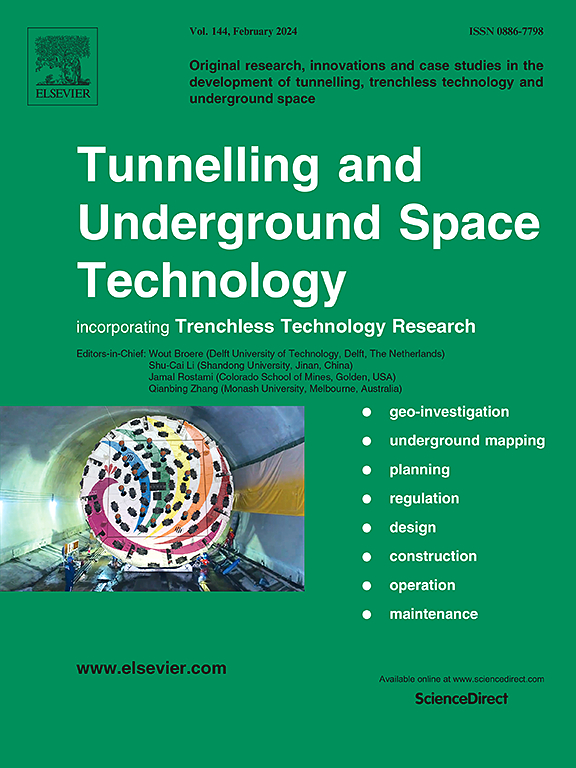软岩蠕变收敛下隧道衬砌回弹性分析:表征及现场应用
IF 6.7
1区 工程技术
Q1 CONSTRUCTION & BUILDING TECHNOLOGY
引用次数: 0
摘要
软岩巷道衬砌回弹性评价是保证软岩巷道结构长期稳定的关键。在本文中,提出了一种新的分析方法来评估其性能,考虑隧道变形的时变特性。基于衬砌的复杂受力特性,选择压拉应力与衬砌强度之比作为回弹性能指标Q。定义了一种新的回弹性度量(Re)来研究衬砌的非均匀应力行为。这个度量是通过结合衬里的空间参数计算出受干扰Q与未受干扰Q的积分之比。最后,以某导流隧洞为例,验证了该方法的合理性和适用性。基于Re对可压缩层支护参数进行了优化。结果表明,衬砌Re显著降低(Re <;3年内为0.6),50年后稳定在0.34。对衬砌Q行为的分析表明,在施工过程中,拱脚和倒拱经历了更大幅度的Q降低。当达到临界阈值时,可压缩层作为支撑的结合增强了衬里的持续弹性,随着时间的推移,将Re保持在大约恒定的水平。这种改进取决于可压缩层的能量吸收能力和利用效率。本文章由计算机程序翻译,如有差异,请以英文原文为准。
Resilience analysis of tunnel lining under creep-induced convergence of soft rock: Characterization and field application
Assessment of tunnel lining resilience is critical to ensure long-term structural stability under soft rock excavation. In this paper, a novel analytical approach is proposed to assess its performance, considering the time-dependent properties of tunnel deformation. Based on the complex stress behavior of lining, the ratio of compressive and tensile stress to its strength is selected as a performance indicator (Q) of resilience. A new resilience metric (Re) is defined to explore the non-uniform stress behavior of the lining. This metric is calculated as the ratio of the integral of disturbed Q to that of undisturbed Q by incorporating the spatial parameters of the lining. Subsequently, the rationality and applicability of the proposed method are validated through a case study involving a diversion tunnel exhibiting time-dependent deformation behavior. The parameters of compressible layer support are optimized based on Re. The results indicate that the lining Re decreases substantially (Re < 0.6) within three years and stabilizes at 0.34 after 50 years. The analysis of lining Q behavior reveals that the arch foot and invert experience more substantial reductions in Q during operation. The incorporation of compressible layers as support enhances the sustained resilience of the lining once a critical threshold is reached, maintaining Re at an approximately constant level over time. This improvement depends on the energy absorption capacity and utilization efficiency of compressible layers.
求助全文
通过发布文献求助,成功后即可免费获取论文全文。
去求助
来源期刊

Tunnelling and Underground Space Technology
工程技术-工程:土木
CiteScore
11.90
自引率
18.80%
发文量
454
审稿时长
10.8 months
期刊介绍:
Tunnelling and Underground Space Technology is an international journal which publishes authoritative articles encompassing the development of innovative uses of underground space and the results of high quality research into improved, more cost-effective techniques for the planning, geo-investigation, design, construction, operation and maintenance of underground and earth-sheltered structures. The journal provides an effective vehicle for the improved worldwide exchange of information on developments in underground technology - and the experience gained from its use - and is strongly committed to publishing papers on the interdisciplinary aspects of creating, planning, and regulating underground space.
 求助内容:
求助内容: 应助结果提醒方式:
应助结果提醒方式:


